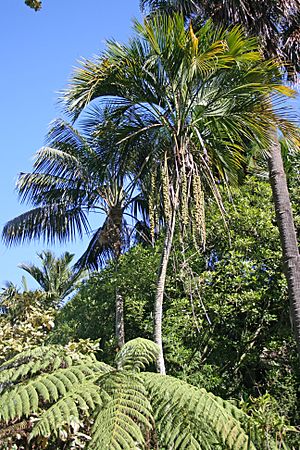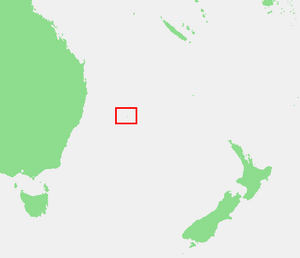Howea facts for kids
Quick facts for kids Howea |
|
|---|---|
 |
|
| Howea forsteriana, left, and H. belmoreana, centre | |
| Scientific classification |
|
| Kingdom: | Plantae |
| Clade: | Tracheophytes |
| Clade: | Angiosperms |
| Clade: | Monocots |
| Clade: | Commelinids |
| Order: | Arecales |
| Family: | Arecaceae |
| Subfamily: | Arecoideae |
| Tribe: | Areceae |
| Subtribe: | Linospadicinae |
| Genus: | Howea Becc. |
| Species | |
|
|
 |
|
| Both Howea spp. are endemic to Lord Howe Island | |
The Howea is a special group of two types of palm trees. Their scientific names are H. belmoreana and H. forsteriana. These palms are found only on Lord Howe Island in Australia. One type, H. forsteriana, is very popular as an indoor plant in many parts of the world. Both types are super important for Lord Howe Island's economy. People on the island grow these palms to sell their seeds and young plants. They are also grown on Norfolk Island for export.
Contents
What Do Howea Palms Look Like?
Both Howea palm types are medium-sized and don't have thorns. This means they are "unarmed." Each palm tree has both male and female flowers, which is called "monoecious."
Their main stem, called the trunk, stands straight up. It's usually smooth and has clear marks where old leaves used to be. Sometimes, the bottom of the trunk looks a bit wider, like a knob. Unlike some other palms, Howea trees don't have a "crownshaft." A crownshaft is a smooth, often green, part at the top of the trunk where the leaves attach.
The leaves of Howea palms are "pinnate," which means they look like feathers with lots of small leaflets arranged along a central stem. The base of each leaf wraps around the trunk. As the leaves get older and fall off, these bases break down into a criss-crossed net of thin fibers around the trunk.
The flower clusters, called "inflorescences," first grow upwards. Later, they hang down. They grow from between the leaf stems. However, as older leaves fall off, the flower clusters might look like they are growing from lower down on the trunk.
How to Tell the Two Howea Species Apart
It can be tricky to tell the two Howea species apart, but their leaves are the biggest clue!
- Howea forsteriana: This palm has leaves that are quite flat. Its small leaflets hang down gracefully, giving the whole leaf a soft, elegant look. Its flower clusters usually have 3 to 5 spikes, but sometimes up to 8, all growing from one wide base. The main stem of its central and lower leaves is usually flat and droopy.
- Howea belmoreana: This palm has leaves that are more curved. Its leaflets stand up straight, making the leaves look more angular. Its flower cluster is usually just a single spike. The main stem of its leaves is curved.
So, if you see a palm with flat, droopy leaves, it's probably H. forsteriana. If the leaves are curved with upright leaflets, it's likely H. belmoreana.
Where Do Howea Palms Grow?
H. forsteriana is very common in the low-lying forests of Lord Howe Island. It especially likes sandy soils. H. belmoreana can also be found scattered among H. forsteriana trees. However, H. belmoreana becomes much more common at higher elevations on the island, growing up to 450 meters (about 1,476 feet) high.
It's rare for these two species to create "hybrid" plants (a mix of both). This is because H. forsteriana flowers about seven weeks earlier than H. belmoreana. This difference in flowering time means they don't usually pollinate each other.
Growing Howea Palms
Lord Howe Island, where these palms come from, has a "subtropical" climate. This means it has mild to warm summers with regular rain, and winters that are wetter and a bit cooler.
- In winter, the highest temperatures are usually between 17°C and 20°C (63°F to 68°F). The lowest temperatures are between 12°C and 15°C (54°F to 59°F).
- In summer, the highest temperatures are usually between 24°C and 27°C (75°F to 81°F). The lowest temperatures are between 18°C and 22°C (64°F to 72°F).
- The air is usually quite humid, around 60% to 70% all year.
Howea palms grow well in subtropical areas. They can also survive in "USDA Hardiness Zone 9b," which means they can handle temperatures down to about -3.9°C (25°F) for short periods. They are widely grown in places with warm, mild climates. You can even find healthy ones in tropical places like Hawaii.
H. belmoreana is not as often grown indoors as H. forsteriana. This is because H. belmoreana has upright leaves and doesn't do as well when kept in a pot. H. forsteriana, on the other hand, is known for its graceful, drooping leaves and is often called the Kentia palm. It's a very popular choice for homes and offices around the world.
See also
 In Spanish: Howea para niños
In Spanish: Howea para niños

